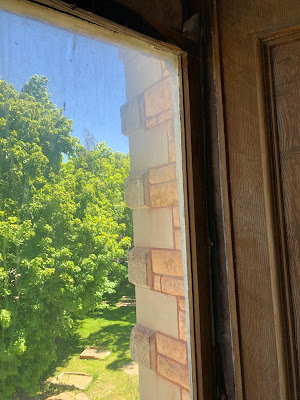“From 1889 to 1917, Latter-day Saint converts from Polynesia settled in Iosepa, a remote desert colony in Utah’s Skull Valley. Archaeological investigations at the town site have revealed how these pioneers from the Pacific sought to make the desert "blossom as the rose" by drawing upon their traditional cultures and their newfound faith.” (source)
our tour bus
flags from Polynesian countries mark Iosepa's cemetery
one of the town's fire hydrants
Iosepa has several underground ovens. The largest pit accommodates 700 pounds of meat. Another hole holds 500#. They dug a special one for us since they were cooking “just” 50 pounds for us. Pork roasts were wrapped in foil, put in a wire basket, lowered into the hole, put on top of stones that covered a fire. Then the food was covered with watercress, covered with burlap, and then covered with dirt. The process started at 3 am!!!
uncovering the oven - removing the tarp, then the soil
removing the burlap
watercress on top of the basket of meat
the basket of foil-wrapped meat
We also had chicken teriyaki, rice, macaroni salad, fruit, and guava cake.
lunchtime entertainment
reproductions of petroglyphs found in mountains above the town site
The men standing are from the two families that bought the land that includes the Iospea town site, cemetery, and pavilion built by the Iosepa Historical Association. Before building anything on the ranch the owners check to make sure it won't negatively affect any Iosepa sites (the man sitting on the stage is from Fiji)
from the cemetery looking towards the town site
Dishes made in Ohio were found at the town site
with artifacts from the schoolhouse
George Sadowski (left), descendent of people who lived in Iosepa. George’s mother was full blooded Hawaiian and his father was Polish. George is a shirt cousin. His Sadowski people didn’t come to the States from Poland until 1940s or so. Ours came over in the early 1700s. I talked with George for a long time about the Sadowski line. He knew a lot about his Hawaiian ancestry but nothing about his Polish ancestry. 
Iosepa in the distance - you can see the pavilion in the center at the base of the mountain
************
added June 29, 2019
The three people on the left work for Ensign Ranch, the group that owns the land that includes Iosepa. The two men in black ball caps are George & Michael Sadowski, our shirttail cousins. Man on the right is archeologist Benjamin Pykles.

























































